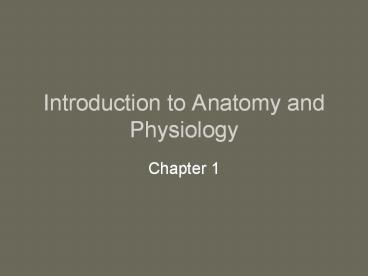Introduction to Anatomy and Physiology - PowerPoint PPT Presentation
1 / 26
Title:
Introduction to Anatomy and Physiology
Description:
Introduction to Anatomy and Physiology Chapter 1 ... The digestive & respiratory system take in nutrients & oxygen which are distributed throughout the body by the ... – PowerPoint PPT presentation
Number of Views:360
Avg rating:3.0/5.0
Title: Introduction to Anatomy and Physiology
1
Introduction to Anatomy and Physiology
- Chapter 1
2
The Systems- Review Table
- Done! And we made our Cadaver Models.
- IMPORTANT POINT Models are only representative
of structures/functions. They give us something
to manipulate to help us understand or a way for
us to see a process/concept that we cant
normally see. - Models are important in science BUT they are not
perfect. - A model can be 3D, a 2D picture or animationetc.
3
Organs are PACKED in!
4
What is Anatomy Physiology?
- Anatomy
- study of the structure and shape of the body and
its parts - Physiology
- study of how the body and its parts work or
function
5
Anatomy Levels of Study
- Gross Anatomy
- Large structures
- Easily observable
6
Anatomy Levels of Study
- Microscopic Anatomy
- Very small structures
- Can only be viewed with a microscope
Figure 14.4
7
- How does MICRO MACRO relate to AP?
- Majority of this class focuses on the organ
system level BUT to understand how organs work we
need to understand the microscopic structures
chemical reactions which happen there!
8
Structural and Functional Organization
www.hkpe.net/.../images/body_levels.jpg
9
- Understanding Diagrams is vital to science!
- Using this picture you and your table should
- 1. fill in as many graphically represented body
systems parts as you can - 2. describe what the arrows depict
- 3. then write a paragraph describing what the
diagram is depicting in general on the back of
the paper. - I will be coming around to help you?
10
Integumentary
food
CO2
O2
Respiratory
Digestive
Cells
nutrients
Nutrients/O2 in Waste/CO2 out
Cardiovascular
Interstitial fluid
Nitrogenous Waste/Salts
Urinary
feces
Urine
11
- Example The picture depicts how all of the organ
systems are connected. We can see that the
integumentary system protects the body from the
external environment. The digestive
respiratory system take in nutrients oxygen
which are distributed throughout the body by the
circulatory system. The circulatory system then
moves waste products to the respiratory system
(carbon dioxide) excretory system (urine).
12
Important POINT!
- NO organ system is completely separate from
another. They all work together. - YOU CAN live (a long healthy life) with out one
of the systemswhich one???
13
Homeostasis
- Your body works because its constantly working
to achieve homeostasis. - Homeo same
- Stasis state
14
- Whenever you do anything you put your homeostasis
in jeopardy. - Ex drinking fanta LOTS of sugar
- high blood sugar release of insulin
absorption of sugar in to cells to be metabolized
? - If you do not produce insulin diabetic, then
you have a major problem b/c unmetabolized sugar
is DEADLY. YOUR HOMEOSTASIS is out of wack!
15
- Negative feedback loops
- Loop opposes the stimulus
- Becomes too hot-action is to cool down OR too
cold shiver to warm up. - Used to regulate body phyiology (not just
temperature) - Ex home central heat/air
16
- Positive Feedback loops
- Increases the stimulus
- vicious cycle
- Not a way to regulate b/c drives body away form
balance - Sometimes it IS necessary
- Ex Child birth
- Contractions continue to increase in strength
until baby is born
17
Overview of Homeostasis
Figure 1.4
18
- Answer the following question on your own on a
sheet of paper put your answer in the bin. - When becoming dehydrated we usually feel thirsty
which causes us to drink fluids. Determine
whether the thirst sensation is part of a
negative or positive feedback loop and defend
your choice.
19
- 1. Fix your cadaver. Use the books in this room
to check placement. - 2. Take tracing paper create the regions (with
names) over your organs. - A) On a separate sheet of paper draw the regions
and their names then list the organs that fall
in each region. - 3. Take a new sheet of tracing paper create
the quadrants over your organs. - A) On the other side of your paper draw the
quadrants/names list the organs in each.
20
The Language of Anatomy
- Special terminology is used to prevent
misunderstanding - Exact terms are used for
- Position
- Direction
- Regions
- Structures
21
- Liver
- Gall bladder
- Stomach
- Lg/Sm Intestine
- Diaphragm
- Liver
- Stomach
- Lg/sm intestine
- Diaphram
- Lg/sm Intestine
- Bladder
- Lg/sm intestine
- Bladder
22
Right Hypochondriac Liver Gall bladder Diaphragm Epigastric Liver Stomach Lg. Intestine Diaphragm Left Hypochondriac Stomach Lg. intestine Sm. Intestine Diaphragm
Right Lumbar Lg intestine Unbilical Lg/sm intestine Left Lumbar Lg/sm intestine
Right Iliac Lg intestine Hypogastric Sm. Intestine Bladder Left Iliac Lg. Intestine
23
Body Planes
Figure 1.6
24
Visible Human Project
- http//www.nlm.nih.gov/research/visible/mpeg/umd_v
ideo.mpg - http//www.madsci.org/lynn/VH/planes.html
25
Visible Human Project
- http//anatquest.nlm.nih.gov/AnatQuest/AwtCsViewer
/aq-cutaway.html - Cavities in reality
26
Body Cavities
Figure 1.7































